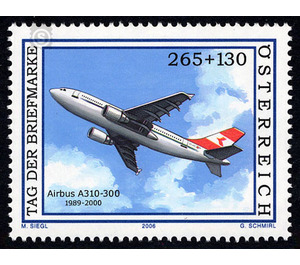day of the stamp - Austria / II. Republic of Austria 2006 - 265 Euro Cent
Theme: Traffic, Transportation & Mobility
| Country | Austria / II. Republic of Austria |
| Issue Date | 2006 |
| Face Value | 265.00 |
| Edition Issued | 600,000 |
| Printing Type | combination printing |
| Stamp Type | Semi-Postal |
| Item Type | Stamp |
| Chronological Issue Number | 1942 |
| Chronological Chapter | OOS-OE2 |
| SID | 921742 |
| In 54 Wishlists | |
The development of the Austrian airmail from 1945 With the end of the Second World War came also the end of the civil airmail from and to Austria. None of the airports around Vienna had remained functional, but the "occupying powers" were quick to try to facilitate makeshift air traffic.The Americans had chosen the airfield in Langenlebarn near Tulln as a base, the Soviets used Aspern and some smaller airfields in the south and the eastern part of Vienna, the British and the French shared the area in Schwechat The first airmail to and from Austria after the Second World War was the field post to and from members of the Allied occupying forces A restricted foreign post traffic was only allowed for civilians from 2 January 1946 from Austria, however, only by land.Only from 25 March 1946 could be given again airmail to foreign countries, Germany and Japan, however, were still excluded from the postal service.And of course, every letter had to go through the censorship.The first air mail items were derived either practice London with Royal Air Force aircraft or Paris by rail. Great media coverage (also inland) was then the inclusion of direct line traffic by the American airline PAN AM from New to Vienna. As a result, other foreign airlines opened the regular service to and from Austria, which was also documented by corresponding first flight documents. The founding of an independent Austrian airline did not come until 1957. In 1958, the first flight from Vienna to London took place with a plane leased from Norway. In 1969 the AUA, in cooperation with the Belgian SABENA, started the transatlantic service on the Vienna - Brussels - New York route. Originally, a journey through the air was something special for both passengers and the post office, but today the aircraft (also due to the capacity expansions) has long become an everyday means of transport, which of course is also used for mass transportation by Swiss Post. Originally, the free of charge carriage of airline mail was intended only to a few, a few countries, so this was more and more expanded and eventually went into a new concept of postal charges for correspondence. Today, there are only more "priority" broadcasts, which are always derived by the fastest possible route, and "non-priority" broadcasts, which are also allowed to cover part of their journey aboard an aircraft to more distant countries. The integration of airfields in the federal states in the Airmail traffic was reduced over the years more and more. Herbert Judmaier © by author 2006


